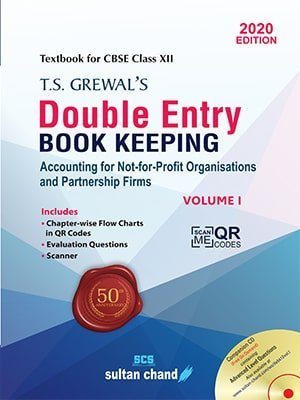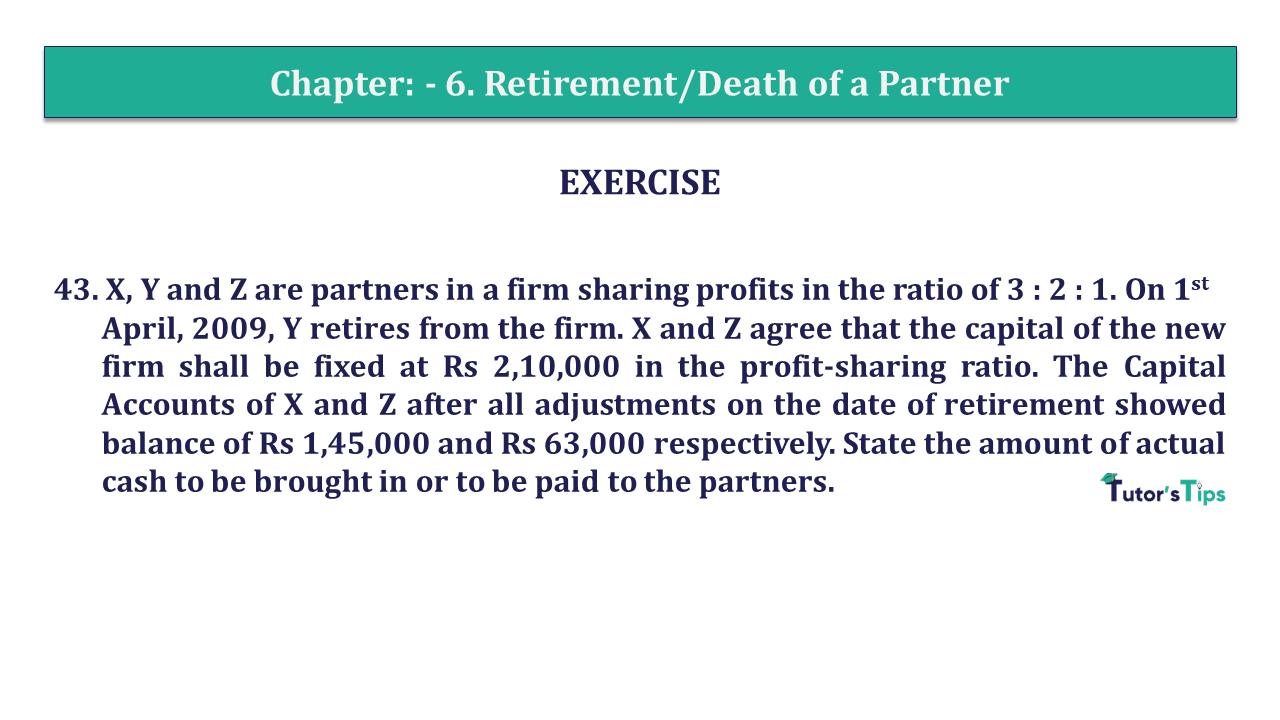Question 44 Chapter 6 of +2-A
44. On 31st March 2019, the Balance Sheet of A, B, and C who were sharing profits and losses in proportion to their capitals stood as:
| Liabilities | Amount | Assets | Amount | ||
| Creditors | 10,800 | Cash at Bank | 13,000 | ||
| Bills Payable | 5,000 | Sundry Debtors | 10,000 | ||
| Capital A/cs: | Less: Provision for Doubtful Debts | 200 | 9,800 | ||
| A’s Capital | 1,00,000 | Stock | 9,000 | ||
| B’s Capital | 60,000 | Machinery | 24,000 | ||
| C’s Capital | 50,000 |
2,10,000 |
Freehold Premises | 50,000 | |
| 1,05,800 | 1,05,800 | ||||
B retired and the following adjustments were agreed to determine the amount payable to B:
- Out of the amount of insurance premium debited to Profit and Loss Account, 1,000 be carried forward as prepaid Insurance.
- Freehold Premises be appreciated by 10%.
- Provision for Doubtful Debts is brought up to 5% on Debtors.
- Machinery is reduced by 5%.
- Liability for Workmen Compensation to the extent of 1,500 would be created.
- Goodwill of the firm be fixed at 18,000 and B’s share of the same be adjusted into the accounts of A and C who will share future profits in the ratio of 3/4th and 1/4th.
The total capital of the firm as newly constituted be fixed at 60,000 between A and C in the proportion of 3/4th and 1/4th after passing entries in their accounts for adjustments, i.e., actual cash to be paid or to be brought in by continuing partners as the case may be.
B be paid 5,000 in cash and the balance be transferred to his Loan Account.
Prepare Capital Accounts of Partners and the Balance Sheet of the firm of A and C.
The solution of Question 44 Chapter 6 of +2-A: –
| Revaluation Account |
|||||
| Particular |
Amount | Particular | Amount | ||
| To Provision for Doubtful Debts | 2,000 | By Prepaid Insurance A/c | 1,000 | ||
| 500 – 200 | By Freehold Premises A/c | 5,000 | |||
| To Machinery A/c | 1,200 | (50,000 × 10%) | |||
| To O/s Workmen’s Compensation A/c | 1,500 | ||||
| To Profit transferred to | |||||
| A’s Capital | 1,500 | ||||
| B’s Capital | 1,000 | ||||
| C’s Capital | 500 | 3,000 | |||
| 6,000 | 6,000 | ||||
| Partners’ Capital Account |
|||||||
| Part. | A | B | C |
Part. |
A | B | C |
| To B’s Capital A/c (Goodwill) | 4,500 | – | 1,500 | By Balance B/d | 45,000 | 30,000 | 15,000 |
| To Bank A/c | – | 5,000 | – | By Revaluation A/c | 1,500 | 1,000 | 500 |
| By A’s Capital A/c | 4,500 | ||||||
| To X’s Loan A/c | – | 32,000 | – | By C’s Capital A/c | 1,500 | ||
| To Balance c/d | 45,000 | – | 15,000 | By Cash A/c | 3,000 | 1,000 | |
| 49,500 | 37,000 | 16,500 | 49,500 | 37,000 | 16,500 | ||
| Balance Sheet |
||||||
| Liabilities |
Amount | Assets |
Amount | |||
| Sundry Creditors | 25,000 | Cash at Bank | 12,000 | |||
| Loan Payable | 15,000 | Debtors | 10,000 | |||
| C’s Loan A/c | 32,125 | Less: Prov. For D/D | 500 | 9,500 | ||
| Stock | 9,000 | |||||
| Capital: | Machinery Freehold Premises |
22,800 | ||||
| A’s Capital | 29,850 | 55,000 | ||||
| B’s Capital | 51,775 | 81,625 | Prepaid Insurance | 1,000 | ||
| 1,09,300 | 1,09,300 | |||||
| Bank Account |
|||||
| Particular |
Amount | Particular | Amount | ||
| To Balance B/d | 13,000 | By B’s Capital A/c | 5,000 | ||
| To A’s Capital A/c | 3,000 | ||||
| To C’s Capital A/c | 1,000 | ||||
| By Balance c/d (B.Fig) | 12,000 | ||||
| 17,000 | 17,000 | ||||
Working Note: –
i. Calculation of B’s share of goodwill
Old Ratio of X, Y, and Z = In their Capital Share
= 45,000 : 30,000 : 15,000
= 3: 2: 1
New Ratio of X and Z = 3:1
Gaining Ratio
| X’s Gain | = | 3 | – | 3 |
| 4 | 6 | |||
| = | 9 | – | 6 | |
| 12 | ||||
| = | 3 | |||
| 12 | ||||
| Y’s Gain | = | 1 | – | 1 |
| 4 | 6 | |||
| = | 3 | – | 2 | |
| 12 | ||||
| = | 1 | |||
| 12 | ||||
Gaining Ratio = 3: 1
Advertisement-X
Adjustment of Goodwill
Goodwill of the firm = Rs 18,000
| B’s Share of Goodwill | = | 18,000 | X | 2 |
| 4 | ||||
| = | Rs 6,000 |
This share of goodwill is to be distributed between X and Z in their gaining ratio i. e. 3:1
| A’s Share | = | 6,000 | X | 3 |
| 4 | ||||
| = | Rs 4,500/- |
| C’s Share | = | 6,000 | X | 1 |
| 4 | ||||
| = | Rs 1,300/- |
Adjustment of Partners’ Capital after B’s Retirement
Total Capital of the New Firm after B’s retirement = 60,000 (Given)
New Ratio of X and Z = 3:1
| A’s New Capital | = | New Total Capital | X | A’s New Shares |
| = | 60,000 | X | 3 | |
| 4 | ||||
| = | Rs 45,000 |
| B’s New Capital | = | New Total Capital | X | A’s New Shares |
| = | 60,000 | X | 1 | |
| 4 | ||||
| = | Rs 15,000 |
Calculation of Addition/withdrawal of Capital by the A and C
| Addition/withdrawal of Capital | = | New Capital | – | Balance of Capital Amount after all adjustments |
| Balance of Capital Amount after all adjustments | = | Opening Balance of Capital Account | + | All Credits | – | All Debits | |
| Balance of A’s Capital Amount after all adjustments | = | 45,000 | + | 1,500 | – | (4,500) | |
| = | 42,000/- | ||||||
Advertisement-Y
| Balance of C’s Capital Amount after all adjustments | = | 15,000 | + | 500 | – | (1,500) | |
| = | 14,000/- | ||||||
calculation of Addition/withdrawal of Capital by the X and Y
|
Addition/withdrawal by A’s in/from Capital A/c |
= | New Capital Amount | – | Balance of Capital Amount after all adjustments |
| = | 45,000 | – | 42,000 | |
| = | 3,000/- |
| addition/withdrawal by Y’s in/from Capital A/c | = | New Capital Amount | – | Balance of Capital Amount after all adjustments |
| = | 15,000 | – | 14,000 | |
| = | 1,000/- |
Advertisement-X
T.S. Grewal’s Double Entry Book Keeping +2 (Vol. I: Accounting for Not-for-Profit Organizations and Partnership Firms)
- Chapter No. 1 – Financial Statement of Not-For-Profit Organisations
- Chapter No. 2 – Accounting for Partnership Firms – Fundamentals
- Chapter No. 3 – Goodwill: Nature and Valuation
- Chapter No. 4 – Change in Profit-Sharing Ratio Among the Existing Partners
- Chapter No. 5 – Admission of a Partner
- Chapter No. 6 – Retirement/Death of a Partner
- Chapter No. 7 – Dissolution of a Partnership Firm
T.S. Grewal’s Double Entry Book Keeping (Vol. II: Accounting for Companies)
- Chapter No. 8 – Company Accounts – Accounting for Share Capital
- Chapter No. 9 – Company Accounts – Issue of Debentures
- Chapter No. 10 – Redemption of Debentures
T.S. Grewal’s Double Entry Book Keeping (Vol. II: Accounting for Companies)
- Chapter No. 1 – Financial Statements of a Company
- Chapter No. 2 – Financial Statement Analysis
- Chapter No. 3 – Tools of Financial Statement Analysis – Comparative Statements and Common- Size Statements
- Chapter No. 4 – Accounting Ratios
- Chapter No. 5 – Cash Flow Statement
Check out T.S. Grewal +2 Book 2020@ Official Website of Sultan Chand Publication








1 Comment